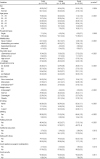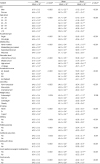1. World Health Organization. Diet, nutrition and the prevention of chronic diseases. . Geneva: World Health Organization;2003. p. 916.
2. World Health Organization. Global action plan for the prevention and control of noncommunicable diseases 2013–2020. Geneva: World Health Organization;2013.
3. Forouzanfar MH, Afshin A, Alexander LT, Anderson HR, Bhutta ZA, Biryukov S. Global, regional, and national comparative risk assessment of behavioural, environmental and occupational, and metabolic risks or clusters of risks, 1990-2015: a systematic analysis for the Global Burden of Disease Study 2015. Lancet. 2016; 388(10053):1659–1724. DOI:
10.1016/S0140-6736(15)00128-2.
4. Kennedy ET, Ohls J, Carlson S, Fleming K. The healthy eating index: design and applications. J Am Diet Assoc. 1995; 95(10):1103–1108.
5. Haines PS, Siega-Riz AM, Popkin BM. The diet quality index revised: a measurement instrument for populations. J Am Diet Assoc. 1999; 99(6):697–704. DOI:
10.1016/S0002-8223(99)00168-6.
6. Kim S, Haines PS, Siega-Riz AM, Popkin BM. The diet quality index-international (DQI-I) provides an effective tool for cross-national comparison of diet quality as illustrated by China and the United States. J Nutr. 2003; 133(11):3476–3484. DOI:
10.1093/jn/133.11.3476.
7. Guenther PM, Casavale KO, Reedy J, Kirkpatrick SI, Hiza HA, Kuczynski KJ. Update of the healthy eating index: HEI-2010. J Acad Nutr Diet. 2013; 113(4):569–580. DOI:
10.1016/j.jand.2012.12.016.
8. Woodruff SJ, Hanning RM. Development and implications of a revised Canadian healthy eating index (HEIC-2009). Public Health Nutr. 2010; 13(6):820–825.
9. Yook SM, Park S, Moon HK, Kim K, Shim JE, Hwang JY. Development of Korean Healthy Eating Index for adults using the Korea National Health and Nutrition Examination Survey data. J Nutr Health. 2015; 48(5):419–428. DOI:
10.4163/jnh.2015.48.5.419.
10. Korea Centers for Disease Control and Prevention. The Sixth Korea National Health and Nutrition Examination Survey (KNHANES 2013–2015) Microdata user guide. Osong: Korea Centers for Disease Control and Prevention;2019.
11. Variyam JN, Blaylock J, Smallwood D, Basiootis PP. USDA's Healthy Eating Index and Nutrition Information. Washington, DC: Economic Research Service and Center for Nutrition Policy and Promotion, USDA;1998.
12. Al-Ibrahim AA, Jackson RT. Healthy eating index versus alternate healthy index in relation to diabetes status and health markers in U.S. adults: NHANES 2007-2010. Nutr J. 2019; 18(1):26. DOI:
10.1186/s12937-019-0450-6.
13. Subhan FB, Chan CB. Diet quality and risk factors for cardiovascular disease among South Asians in Alberta. Appl Physiol Nutr Metab. 2019; 44(8):886–893. DOI:
10.1139/apnm-2018-0868.
14. Morton LW, Bitto EA, Oakland MJ, Sand M. Accessing food resources: Rural and urban patterns of giving and getting food. Agric Hum Values. 2008; 25(1):107–119.
15. Sharkey JR, Johnson CM, Dean WR. Food access and perceptions of the community and household food environment as correlates of fruit and vegetable intake among rural seniors. BMC Geriatr. 2010; 10(1):32.
16. Dean WR, Sharkey JR. Rural and urban differences in the associations between characteristics of the community food environment and fruit and vegetable intake. J Nutr Educ Behav. 2011; 43(6):426–433. DOI:
10.1016/j.jneb.2010.07.001.
17. Caspi CE, Sorensen G, Subramanian SV, Kawachi I. The local food environment and diet: A systematic review. Health Place. 2012; 18(5):1172–1187. DOI:
10.1016/j.healthplace.2012.05.006.
18. Lee JH. The regional health inequity, and individual and neighborhood level health determinants. Health Soc Welf Rev. 2016; 36(2):345–384. DOI:
10.15709/hswr.2016.36.2.345.
19. Yoon TH. Regional health inequalities in Korea: The status and policy tasks. J Crit Soc Welf. 2010; 30(8):49–77.
20. Yun S. Development and status of Korean Healthy Eating Index for adults based on the Korea National Health and Nutrition Examination Survey. Nutrition and Dietetics. 2019; 42(2):14–19.
21. Ministry of Health and Welfare. A study on the establishment of the life cycle-based dietary guidelines for Koreans. Sejong: Ministry of Health and Welfare;2016.
22. Jung HW, Kim SW, Kim IY, Lim JY, Park HS, Song W. Protein intake recommendation for Korean older adults to prevent sarcopenia: Expert consensus by the Korean Geriatric Society and the Korean Nutrition Society. Ann Geriatr Med Res. 2018; 22(4):167–175. DOI:
10.4235/agmr.18.0046.
23. Kim HR. A study on the association of diet quality and risk of mortality and major chronic diseases from nationally representative longitudinal data. Health Soc Welf Rev. 2013; 33(3):5–30. DOI:
10.15709/hswr.2013.33.3.5.
24. Park GA, Kim SH, Kim SJ, Yang YJ. Health and nutritional status of Korean adults according to age and household food security: Using the data from 2010~2012 Korea National Health and Nutrition Examination Survey. J Nutr Health. 2017; 50(6):603–614. DOI:
10.4163/jnh.2017.50.6.603.
25. Lee JH. The regional health inequity, and individual and neighborhood level health determinants. Health Soc Welf Rev. 2016; 36(2):345–384. DOI:
10.15709/hswr.2016.36.2.345.
26. Lytle LA. Measuring the food environment: State of the science. Am J Prev Med. 2009; 36(4 Suppl):S134–S144. DOI:
10.1016/j.amepre.2009.01.018.
27. Yoon H, Kwoun J, Lee S. Nutritional status and energy expenditure in the elderly in a rural community. Korean J Community Nutr. 2002; 7(3):336–344.
28. Cho YE, Lee SL, Cho EH, Lomeda RL, Kwak EH, Kim YH. Comparison of nutrient intakes of Korean elderly people living in rural area between 24-hour recall and food frequency method. J Korean Soc Food Sci Nutr. 2006; 35(6):698–707. DOI:
10.3746/jkfn.2006.35.6.698.
29. Lee Y, Choi Y, Park HR, Song KH, Lee KE, Yoo CH. Comparative analysis of dietary behavior and nutrient intake of elderly in urban and rural areas for development of “Village Lunch Table” program: Based on 2014 Korea National Health and Nutrition Examination Survey data. J Nutr Health. 2017; 50(2):171–179. DOI:
10.4163/jnh.2017.50.2.171.
30. Choi HJ, Yoo JH. The effect of depression and self-efficacy on health promotion behavior among the elderly living alone in rural area. J East West Nurs Res. 2011; 17(2):149–155. DOI:
10.14370/jewnr.2011.17.2.149.
31. Lee MS. Health-related factors influencing the quality of life of rural elderly subjects-activities of daily living, cognitive functions, prevalence of chronic diseases and nutritional assessment. Korean J Community Nutr. 2012; 17(6):772–781. DOI:
10.5720/kjcn.2012.17.6.772.
32. Park E. A comparison of community health status by region and an investigation of related factors using community health indicators. J Korean Acad Community Health Nurs. 2012; 23(1):31–39. DOI:
10.12799/jkachn.2012.23.1.31.
33. Glanz K, Sallis JF, Saelens BE, Frank LD. Healthy nutrition environments: Concepts and measures. Am J Health Promot. 2005; 19(5):330–333. DOI:
10.4278/0890-1171-19.5.330.
34. Sharkey JR, Johnson CM, Dean WR. Food access and perceptions of the community and household food environment as correlates of fruit and vegetable intake among rural seniors. BMC Geriatr. 2010; 10(1):32.
35. Lee KI, Hwang YJ, Lee DS, Kim GY, Lee YN, Kim K. Strategic approach toward vitalizing food assistance programs. Naju: Korea Rural Economic Institute;2012. p. 680.
36. Lee CH, Lee SE, Jang MJ, Choe JS, Park YH, Kim Y. An analysis of food purchase accessibility and availability for rural households: The cases of Bibong-myeon and Maesong-myeon, Hwaseong-si. Korean J Community Living Sci. 2014; 25(4):581–600. DOI:
10.7856/kjcls.2014.25.4.581.
37. Shim JE, Kim SJ, Kim K, Hwang JY. Spatial disparity in food environment and household economic resources related to food insecurity in rural Korean households with older adults. Nutrients. 2018; 10(10):E1514. DOI:
10.3390/nu10101514.
38. Shim JE, Hwang JY, Kim K. Objective and perceived food environment and household economic resources related to food insecurity in older adults living alone in rural areas. BMC Geriatrics. 2019; 19(1):234. DOI:
10.1186/s12877-019-1231-y.
39. Oh MH, Choe JS, Kim Y, Lee SE, Paik HY, Jang MJ. Customer perception and expert assessment in restaurant food environment by region: Focused on restaurants in Suwon, Hwaseong city. J Nutr Health. 2014; 47(6):463–474. DOI:
10.4163/jnh.2014.47.6.463.









 PDF
PDF ePub
ePub Citation
Citation Print
Print



 XML Download
XML Download